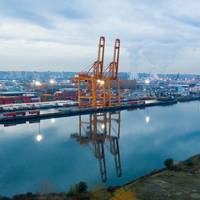US Ports Seek COVID-19 Relief

America’s port authorities are advocating for relief to manage the “extremely negative impacts” on the seaport industry brought on by the coronavirus pandemic as U.S. policymakers begin negotiations on the next COVID-19 aid package.Among the port leaders’ advocacy efforts are letters sent Friday to U.S. House, Senate and Administration leaders, urging them to provide $1.5 billion for seaports to cover business-critical expenses that ports have incurred due to COVID-19. The letters…
Oil Fuel Bunker Station Development in Port of Barcelona, Spain
Aegean Marine Petroleum Network Inc. plans expansion in Barcelona, contracts with Meroil for onshore fuel oil storage. Aegean Marine Petroleum Network has signed an agreement to secure onshore fuel oil storage capacity in Port of Barcelona and plans to start supply operations by the end of Q1 2013. The port of Barcelona serves as a key transportation hub located along major seaborne trade routes, totalling approximately 10,000 transits per year and generating approximately 1.2 million metric tons of annual marine fuel sales volumes. The port, which also benefits from extensive cruise passenger travel, is currently undergoing a modernization and expansion plan headed by the Barcelona Port Authority that is expected to substantially increase the port's capacity upon completion in 2014.
Cruise Passenger Travel Increases by 7 Percent
Passenger cruise travel in 2003 increased by 7 percent over 2002 levels, according to data released by the Maritime Administration today. The top 10 cruise lines carried 2 million passengers on 932 North American cruises in the second quarter of 2003, an increase of 7 percent from the second quarter of 2002. In addition, the first two quarters of 2003 reflect a 9 percent growth from the same period in 2002. Miami remained the largest departure port, accounting for 23 percent of the total traffic. However, Port Canaveral replaced Fort Lauderdale in the second position, after several ships operating from Fort Lauderdale shifted in the second quarter to seasonal markets elsewhere.
Cruise Passenger Travel Grows 13.6%
Reflecting a rise in the popularity of passengers departing from ports closer to their homes, cruise lines carried 2.3 million passengers on North American cruises in the first quarter of 2004, the Maritime Administration (MARAD) reported today. The figures reflect a 13.6 percent increase compared to the same period in 2003. The majority of cruises are still destined for the Caribbean and the Bahamas. However, there has been important growth in new and emerging "drive market" ports -- departure ports closer to home. For example, last year, during the first quarter, four ports -- New York, Jacksonville, Houston, and Norfolk – offered no departures. Now, these cities are currently among the top 15 departure ports in the nation.
MarAd: Cruise Passenger Traffic Shows Continued Growth
For the first nine months of 2005, cruise passenger traffic in North America was 4.5 percent above the same period in 2004, despite the impact of hurricanes on Gulf port cruises, according to third quarter statistics released by the U.S. Maritime Administration. The data, part of the MarAd’s regularly-issued cruise passenger series, also show that cruise passenger traffic is up 18.5 percent over the same period in 2003, the year that MarAd first began publishing these statistics. Moreover, 15 out of the 17 cruise lines analyzed in the series showed an increase in traffic in 2005. Deputy Maritime Administrator John Jamian attributed the overall pattern of growth to “a vibrant U.S. The traffic figures highlight the impact of hurricane Katrina.





